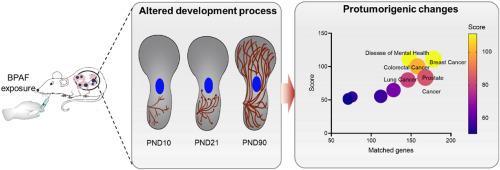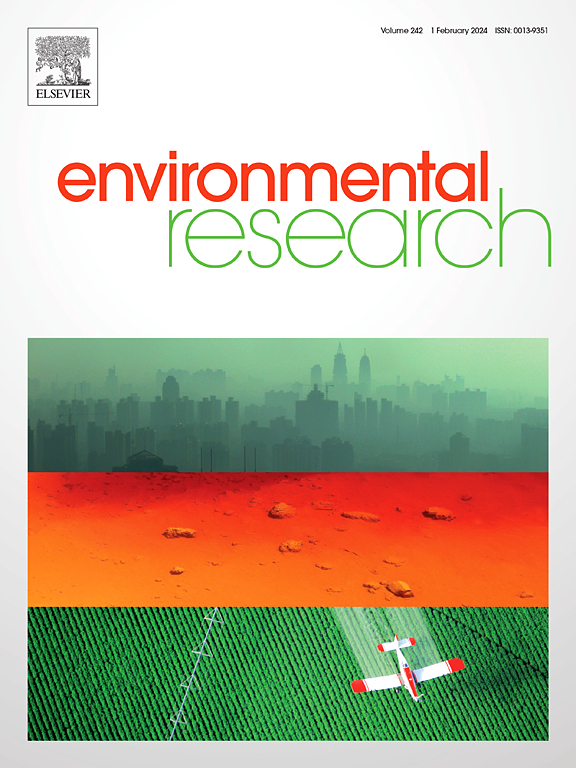产前接触双酚 AF 后幼年雌性小鼠乳腺发育改变和促肿瘤变化
IF 7.7
2区 环境科学与生态学
Q1 ENVIRONMENTAL SCIENCES
引用次数: 0
摘要
由于双酚 A(BPA)具有干扰内分泌的作用,目前正被逐步淘汰,并越来越多地被双酚 AF(BPAF)等替代化合物所取代。本研究旨在探讨产前接触双酚 AF 和产后交叉抚育对后代乳腺发育和长期健康影响的潜在不良后果。结果表明,产前暴露于双酚 AF 会加速青春期的到来,并诱导雌性后代乳腺导管扩张、血管生成、乳腺小叶增生和炎症细胞浸润增强。双酚 AF 暴露所诱导的差异表达基因在乳腺发育、上皮细胞增殖等相关生物过程中表现出时间序列模式。值得注意的是,筛选出的包括 Pgr、Gata3、Egfr 和 Areg 在内的 13 个乳腺癌相关生物标志物的表达呈时间依赖性增加。经过人类同源基因转化后,TCGA 分析表明,在 BPAF 处理的小鼠中差异表达的人类同源基因与女性乳腺癌患者肿瘤分期的增加有关。此外,产后交叉培育并不能完全恢复产前双酚 AF 暴露的不良影响,甚至会出现相反的趋势。这些结果表明,产前在子宫内暴露于双酚 AF 和产后由暴露于双酚 AF 的母鼠哺乳,会对雌性后代的乳腺健康产生长期影响。本文章由计算机程序翻译,如有差异,请以英文原文为准。

Altered mammary gland development and pro-tumorigenic changes in young female mice following prenatal BPAF exposure
Bisphenol A (BPA) is being phased out owing to its endocrine-disrupting effects and is increasingly being replaced by its substitute compounds such as bisphenol AF (BPAF). This study aims to explore the potential adverse outcomes of prenatal BPAF exposure combined with postnatal cross-fostering on the development and long-term health effects of the mammary gland in offspring. The results suggested that prenatal BPAF exposure accelerates the puberty, and induces duct dilatations, angiogenesis, lobular hyperplasia, and enhanced inflammatory cell infiltration in the mammary gland of female offspring. Differentially expressed genes exhibiting time series patterns induced by BPAF exposure were enriched in biological processes related to mammary gland development, epithelial cell proliferation and so on. Notably, 13 breast cancer-related biomarkers including Pgr, Gata3, Egfr and Areg were screened, showing a time-dependent increase in expression. After human homologous gene transformation, TCGA analysis suggested that the human homologues of genes differentially expressed in BPAF-treated mice were associated with increased tumor stages in female patients with breast cancer. Furthermore, postnatal cross-fostering did not completely restore the adverse effects of prenatal BPAF exposure and even showed a reverse tendency. These results imply that prenatal BPAF exposure in utero and postnatally nursing by BPAF exposed dams, have long-term effects on the mammary glands health of female offspring.
求助全文
通过发布文献求助,成功后即可免费获取论文全文。
去求助
来源期刊

Environmental Research
环境科学-公共卫生、环境卫生与职业卫生
CiteScore
12.60
自引率
8.40%
发文量
2480
审稿时长
4.7 months
期刊介绍:
The Environmental Research journal presents a broad range of interdisciplinary research, focused on addressing worldwide environmental concerns and featuring innovative findings. Our publication strives to explore relevant anthropogenic issues across various environmental sectors, showcasing practical applications in real-life settings.
 求助内容:
求助内容: 应助结果提醒方式:
应助结果提醒方式:


